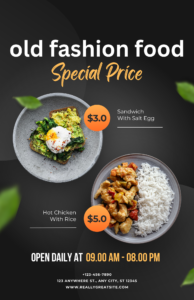Introduction: In the era of fast food and instant meals, the timeless appeal of old-fashioned food holds a special place in our hearts. From hearty stews simmering on the stove to freshly baked pies cooling on the windowsill, traditional culinary delights evoke nostalgia and comfort. For websites dedicated to preserving and celebrating these classic recipes, adhering to webmaster quality guidelines is essential to ensure optimal visibility and engagement. Join us as we explore the intricacies of webmaster quality guidelines tailored for old-fashioned food websites and discover how to elevate your culinary corner of the internet.
Embracing the Heritage of Old-Fashioned Food: Before delving into the nuances of webmaster guidelines, let’s take a moment to appreciate the rich heritage of old-fashioned cuisine. Old-fashioned food encompasses a myriad of dishes and culinary traditions passed down through generations, each carrying a unique story and flavor profile. Whether it’s Grandma’s secret recipe for apple pie or a regional specialty that’s been enjoyed for centuries, these timeless classics form the foundation of our culinary identity and deserve to be preserved and celebrated.
Webmaster Quality Guidelines for Old-Fashioned Food Websites:
- Preserving Authenticity Through Content: Authenticity is the cornerstone of old-fashioned food websites. When creating content, prioritize authenticity by sourcing recipes from trusted culinary sources, incorporating personal anecdotes or family stories, and highlighting the historical significance of each dish. Avoid shortcuts or modern adaptations that compromise the integrity of traditional recipes, and strive to capture the essence of bygone eras in both your writing style and imagery.
-
old

old - Optimizing for Search and User Experience: Effective SEO (Search Engine Optimization) is essential for ensuring that your old-fashioned food website reaches its target audience. Conduct keyword research to identify relevant search terms related to classic recipes, cooking techniques, and nostalgic dining experiences. Incorporate these keywords strategically into your website’s content, headings, meta tags, and image alt text to improve its visibility on search engine results pages (SERPs) without sacrificing readability or authenticity.
- Engaging Visuals and Multimedia Content: In the world of old-fashioned food, visuals play a crucial role in enticing visitors and conveying the rustic charm of traditional dishes. Invest in high-quality photography or videography to showcase your recipes in their best light, capturing the textures, colors, and aromas that make them irresistible. Additionally, consider incorporating multimedia elements such as cooking tutorials, step-by-step guides, or historical anecdotes to enhance the user experience and encourage longer dwell times on your website.
- Building a Community Around Shared Memories: Old-fashioned food is more than just sustenance; it’s a catalyst for nostalgia and shared memories. Foster a sense of community on your website by inviting visitors to share their own family recipes, culinary traditions, and nostalgic anecdotes in comments sections or dedicated forums. Encourage interaction and collaboration among your audience members, creating a virtual gathering place where food enthusiasts can connect, reminisce, and discover new culinary inspirations together.
FAQs (Frequently Asked Questions) About Old-Fashioned Food:
Q1: What are some popular old-fashioned recipes that I can feature on my website? A1: Old-fashioned cuisine encompasses a wide range of beloved recipes, but some perennial favorites include:
- Classic meatloaf with mashed potatoes and gravy
- Homemade chicken noodle soup with hearty vegetables
- Freshly baked apple pie with a flaky crust and cinnamon-spiced filling
- Traditional pot roast slow-cooked with carrots, onions, and potatoes
- Comforting macaroni and cheese made from scratch with sharp cheddar cheese
Q2: How can I adapt traditional recipes to accommodate dietary restrictions or preferences? A2: Adapting old-fashioned recipes to suit dietary restrictions or preferences requires creativity and experimentation. Consider substituting ingredients, such as dairy-free milk alternatives or gluten-free flour blends, while preserving the overall flavor and texture of the dish. Additionally, explore alternative cooking methods, such as grilling or roasting, to achieve similar results with healthier ingredients.
Conclusion: In conclusion, navigating webmaster quality guidelines for old-fashioned food websites is essential for preserving the culinary heritage of yesteryears and connecting with a passionate audience of food enthusiasts. By prioritizing authenticity, optimizing for search and user experience, and fostering community engagement, you can create a digital hub that celebrates the timeless appeal of traditional recipes and fosters a sense of nostalgia and camaraderie among visitors. Embrace these guidelines as pillars of your digital strategy, and watch as your old-fashioned food website becomes a cherished destination for culinary aficionados seeking a taste of the past.
Introduction: In today’s fast-paced culinary landscape dominated by trendy diets and modern gastronomic innovations, there’s a comforting allure to the timeless appeal of old-fashioned food. From generations-old family recipes to regional specialties passed down through the ages, traditional cuisine holds a special place in our hearts and memories. For websites dedicated to preserving and sharing the culinary heritage of yesteryears, adhering to webmaster quality guidelines is crucial to ensure optimal visibility and engagement. Join us as we embark on a journey through the savory realms of old-fashioned food and explore how to navigate webmaster quality guidelines to elevate your culinary corner of the internet.
Embracing the Heritage of Old-Fashioned Food: Before we delve into the intricacies of webmaster guidelines, let’s take a moment to savor the rich tapestry of old-fashioned cuisine. Old-fashioned food embodies more than just sustenance; it encapsulates a cultural heritage, a connection to the past, and a celebration of simpler times. Whether it’s the aroma of freshly baked bread wafting through a country kitchen or the comforting warmth of a bowl of homemade soup on a chilly evening, traditional recipes evoke a sense of nostalgia and culinary craftsmanship that transcends generations.
Webmaster Quality Guidelines for Old-Fashioned Food Websites:
- Preserving Authenticity Through Content: At the heart of every successful old-fashioned food website lies authenticity. When curating content, prioritize authenticity by sourcing recipes from reputable culinary sources, such as vintage cookbooks, family heirlooms, or renowned chefs specializing in traditional cuisine. Infuse your writing with personal anecdotes, historical tidbits, and cultural insights to bring each recipe to life and create a connection with your audience. Avoid shortcuts or modern adaptations that dilute the integrity of traditional dishes, and strive to honor the legacy of each recipe with reverence and respect.
- Optimizing for Search and User Experience: Effective SEO is essential for ensuring that your old-fashioned food website reaches its intended audience. Conduct comprehensive keyword research to identify relevant search terms related to classic recipes, cooking techniques, and nostalgic dining experiences. Integrate these keywords strategically into your website’s content, headings, meta tags, and image alt text to improve its visibility on search engine results pages (SERPs) while maintaining readability and authenticity. Additionally, prioritize user experience by optimizing your website’s navigation, layout, and load times to provide a seamless and enjoyable browsing experience for visitors.
- Engaging Visuals and Multimedia Content: In the realm of old-fashioned food, visuals play a pivotal role in captivating audiences and conveying the rustic charm of traditional dishes. Invest in high-quality photography or videography to showcase your recipes in all their mouthwatering glory, capturing the textures, colors, and flavors that make them irresistible. Experiment with multimedia elements such as cooking tutorials, step-by-step guides, or historical retrospectives to enrich the user experience and encourage longer dwell times on your website. By appealing to both the visual and auditory senses, you can create a sensory journey that transports visitors to a bygone era of culinary craftsmanship and conviviality.
- Building a Community Around Shared Memories: Food has a remarkable ability to evoke memories, foster connections, and spark conversations. Cultivate a sense of community on your old-fashioned food website by inviting visitors to share their own family recipes, culinary traditions, and nostalgic anecdotes in comments sections or dedicated forums. Encourage interaction and collaboration among your audience members, creating a virtual gathering place where food enthusiasts can connect, reminisce, and discover new culinary inspirations together. By fostering a sense of belonging and camaraderie, you can transform your website into a cherished destination where shared memories are celebrated and culinary legacies are preserved for future generations.
FAQs (Frequently Asked Questions) About Old-Fashioned Food:
Q1: What are some popular old-fashioned recipes that I can feature on my website? A1: Old-fashioned cuisine boasts a treasure trove of beloved recipes that have stood the test of time. Some perennial favorites include:
- Classic beef stew simmered to perfection with hearty vegetables and aromatic herbs.
- Homemade apple pie with a flaky crust, cinnamon-spiced filling, and a dollop of whipped cream.
- Traditional meatloaf seasoned with savory spices, topped with tangy ketchup glaze, and baked to golden-brown perfection.
- Hearty chicken pot pie brimming with tender chicken, garden-fresh vegetables, and velvety gravy, all nestled beneath a buttery pastry crust.
- Comforting macaroni and cheese crafted from scratch with sharp cheddar cheese, creamy béchamel sauce, and a crispy breadcrumb topping.
Q2: How can I adapt old-fashioned recipes to accommodate dietary restrictions or preferences? A2: Adapting old-fashioned recipes to suit dietary restrictions or preferences requires creativity and flexibility. Consider experimenting with alternative ingredients and cooking techniques to achieve similar flavors and textures while catering to specific dietary needs. For example, substitute dairy-free milk alternatives or plant-based cheeses for traditional dairy products, or use gluten-free flour blends in place of wheat flour for gluten-sensitive individuals. Additionally, explore innovative cooking methods such as grilling, roasting, or steaming to create healthier versions of classic dishes without compromising on taste or nostalgia.
Conclusion: In conclusion, navigating webmaster quality guidelines for old-fashioned food websites is essential for preserving the culinary heritage of yesteryears and connecting with a passionate audience of food enthusiasts. By prioritizing authenticity, optimizing for search and user experience, and fostering community engagement, you can create a digital haven where traditional recipes are celebrated, shared memories are cherished, and culinary legacies are passed down from one generation to the next. Embrace these guidelines as the cornerstone of your digital strategy, and watch as your old-fashioned food website becomes a beloved destination for culinary aficionados seeking a taste of the past.
